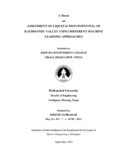Please use this identifier to cite or link to this item:
https://elibrary.khec.edu.np/handle/123456789/860Full metadata record
| DC Field | Value | Language |
|---|---|---|
| dc.contributor.advisor | Er. Sujan Maka; Er. Sunil Duwal | - |
| dc.contributor.author | Bikesh Tamrakar | - |
| dc.date.accessioned | 2025-02-10T10:25:58Z | - |
| dc.date.available | 2025-02-10T10:25:58Z | - |
| dc.date.issued | 2024 | - |
| dc.identifier.uri | https://elibrary.khec.edu.np:8080/handle/123456789/860 | - |
| dc.description.abstract | Kathmandu Valley, situated in the Lesser Himalayas of central Nepal, have been characterized by lacustrine and fluvial deposits, making it highly susceptible to liquefaction. Despite this vulnerability, detailed studies on the valley�s liquefaction potential are limited. Given the significant risk posed by liquefaction, which can be exacerbated by the valley�s unique geological, geotechnical, and hydrological conditions, proper assessment is essential. This research utilized advanced machine learning techniques�random forest (RF) method, support vector machine (SVM), extreme gradient boosting (XGB) method, artificial neural networks (ANN) and deep neural network (DNN)�to evaluate liquefaction susceptibility using event data from Kathmandu Valley. Six key liquefaction conditioning factors were selected based on multicollinearity tests: peak ground acceleration (PGA), avg. shear wave velocity up to 30m depth (Vs30), nearest distance to waterbodies (NDTW), geological formation, sediment thickness, and predominant period. The influence of these parameters on liquefaction susceptibility was assessed using the Cohen Kappa Score in LOOCV test and information gain ratio (IGR), revealing that the predominant period had the greatest impact, followed by sediment thickness, Vs30, and geological formation. Among the machine learning models, RF demonstrated superior performance, as indicated by the Area Under the Curve of Receiver Operating Characteristics (AUROC), outperforming all the other models in liquefaction susceptibility mapping (LSM). The study identified that 2.84 to 3.97% of Kathmandu Valley�s area falls within the very high liquefaction susceptibility category likewise 7.84 to 9.82% within high liquefaction susceptibility, 12.70 to 14.58% within moderate liquefaction susceptibility, 15.43 to 16.39% within low susceptibility and 56.96 to 59.86% within very low susceptibility category, with the central region, particularly the alluvial fan deposits, Chapagaon, Kalimati and Gokarna formations, showing the highest liquefaction potential. These regions were marked by lower average shear wave velocity (Vs30), thick sediment layer and longer predominant periods, conditions that were conducive to liquefaction. The study further validated the obtained map using real-time liquefaction observed during 1934 Nepal-Bihar earthquake and 2015 Gorkha earthquake. These findings highlighted the effectiveness of machine learning approaches in LSM, providing valuable insights for mitigating the impacts of liquefaction in Kathmandu Valley. | - |
| dc.format.extent | 87 p | - |
| dc.title | Assessment of Liquefaction Potential of Kathmandu Valley Using Different MachIne Learning Approaches | - |
| dc.type | Thesis | - |
| local.college.name | Khwopa Engineering College | - |
| local.degree.department | P. G. Department of Earthquake Engineering | - |
| local.college.batch | 2076 | - |
| local.degree.name | ME Earthquake | - |
| local.degree.level | Masters | - |
| local.item.accessionnumber | D.1523 | - |
| local.item.reportnumber | Reg. No.: 035 - 7 - 3 - 04790 - 2021 | - |
| Appears in Collections: | Master of Science (M.Sc) in Earthquake engineering | |
Files in This Item:
| File | Description | Size | Format | |
|---|---|---|---|---|
| 021_Bikesh Tamrakar.pdf Restricted Access | 4.18 MB | Adobe PDF |  View/Open Request a copy |
Items in DSpace are protected by copyright, with all rights reserved, unless otherwise indicated.
